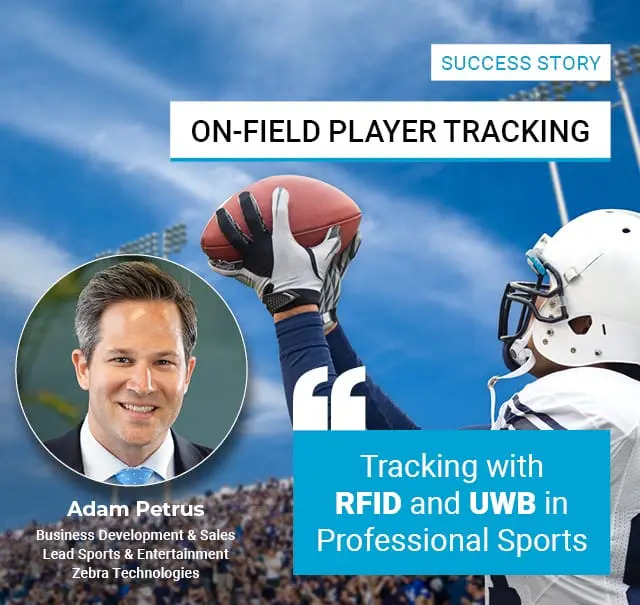NFL IMPROVES PLAYER SAFETY AND FAN EXPERIENCE WITH RFID AND UWB
Player Tracking on the Field
Professional sports are driven by the drive for peak performance and constant optimization. American football in the NFL is no exception. This requires reliable and meaningful data and statistics.
These Next Generation Stats are thanks to Zebra Technologies’ on-field player and ball tracking solution . Players and soccer balls are actively RFID tagged and UWB sensors This allows data to be captured in real-time and made available to NFL teams and fans.
National Football League (NFL)
The NFL is the professional US-American football league. It was founded in 1920 in Canton, Ohio as the American Professional Football Association. It was renamed the National Football League in 1922. As of 2021, the NFL is the most financially successful sports league in the world, generating US$17 billion in annual revenue.
In the NFL, 32 teams play divided into two conferences: American Football Conference (AFC) and National Football Conference (NFC). The conferences are divided into four divisions. Each team plays 3 games in the preseason and 17 games in the regular season. At the end of the season, the top seven teams from each conference compete for the championship in the play-offs. The knockout tournament culminates in the grand finale, the Super Bowl. An estimated 200 million viewers watched the Big Game on Super Bowl Sunday in 2023.

Optimizing Games, Improving Player Safety and Fan Engagement
NFL teams are paying a lot of attention to match-based data. Which player is best suited for each game? How are players performing in practice and in games? Has a player fully recovered from injury? These are just some of the questions that keep coaches, players and general managers of NFL teams busy. Additional data also applies to interacting with fans. How is their favorite team’s quarterback performing in the league? How many yards did the running back rush for in the last game?
The answers to these questions can be found by capturing and evaluating game data. To do this, the NFL has relied on Zebra MotionWorks Sport, Zebra Technologies’ on-field tracking solution, since 2016. Zebra generates data with RFID and UWB, which the NFL uses to capture more than 200 statistics per game, called Next Generation Stats.
SPORTS EQUIPMENT WITH RFID
Player Tracking with Active RFID
A soccer team has a maximum of 53 players. Each player is equipped with two active RFID tags located under the epaulettes of their shoulder pads. The tags are nickel-sized, weigh only 3.3 grams and are just over a quarter of an inch thick. The tags are programmed to transmit real-time location data at 12 Hertz per second. They stay in the equipment for the entire season and can last up to two seasons. Battery replacement is not necessary during the active season.
Additional Labels on the Back
Unlike other players, linemen have a total of three RFID tags. The reason: Before a play, linemen stand in a three or four point stance at the line of scrimmage. In this position, they touch the field with one or both hands. Since the RFID tags are close to the ground, transmission to the receiver antennas is more difficult. The third RFID tag, located in the center back of the shoulder pads, transmits data in this position. More than 300 RFID tags are distributed in a single game.

RFID Tagged Soccer Balls
Technology deployment is not limited to players. Referees, the posts on the pitch and even soccer itself are being tracked with RFID tags. To ensure that performance is not affected, the RFID-tagged soccer ball weighs 400 grams, just like an untagged soccer ball. The ball’s flight characteristics remain unchanged. The integrated RFID tag transmits location data at 25 Hertz per second during play. The RFID soccer ball is a joint development of Zebra Technologies and Wilson Sporting Goods, a sporting goods manufacturer from Ada, Ohio.
UWB SENSORS
UWB sensors with antennas are placed in the stadium and receive captured data from RFID tags. The time from data acquisition to visualization is only 5 seconds.
NFL Football Stadiums with UWB
Each of the 32 NFL stadiums is equipped with 22 to 24 antennas. Low-gain, medium-gain and high-gain antennas are deployed. Antenna installation typically takes place at the 200 level, the center section of the stadium. From here the sensor antennas receive location data from the RFID tags. The maximum reading distance is 350 feet. Due to the different radiation patterns, full antenna coverage is guaranteed, covering the entire 120 x 53.3 yard range.
Why UWB?
Compared to other radio technologies, UWB offers higher location accuracy. This is achieved by measuring the signal propagation time between the transmitter and at least three receivers, not the signal strength. The tag signal is received at different times by all receivers in the stadium, depending on the distance. The time difference is multiplied by the constant speed of light to calculate the coordinates of the transmitter. The position is accurately determined in inches.

Data Visualization with Zebra MotionWorks
After the data is received by the antennas, the captured data is transmitted via a protected Ethernet cable to the end device and the MotionWorks software. This process takes 50 milliseconds. The software acts as a layer that identifies each player and processes the location data. The result: real-time visualization of player and football position data on the dashboard. The data is then processed through buffering and filtering and transmitted to the NFL in just 5 seconds. MotionWorks software processes 260 data points per play. On a typical game day, 750 million data points are transferred and converted into statistics.
ZEBRA MOTIONWORKS™
RTLS for various use cases:
- Personnel tracking
- Tracking of vehicles, materials, tools and equipment
- Material flow management and inventory replenishment
Application Areas:
Sports, Logistics, Automotive, Aviation, Industrial Production, Healthcare
Source: https://www.rfid-wiot-search.com/zebra-nfl-on-field-player-tracking#teaser2

